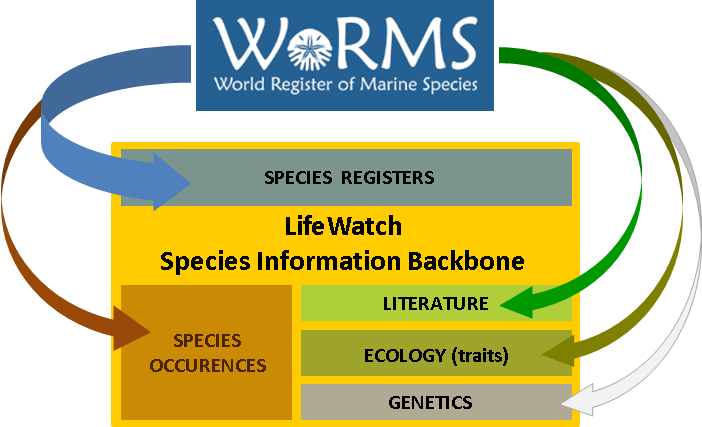What is LifeWatch?
Background

LifeWatch was established as part of the European Strategy Forum on Research Infrastructure (ESFRI) and can be seen as a virtual laboratory for biodiversity research. The concept behind LifeWatch was developed in the 1990s and early 2000s, with the support of EU Networks of Excellence related to biodiversity and ecosystem functioning. This - amongst others - included the MarBEF project, which was the driving project behind the creation of the European Register of Marine Species (ERMS) data system - the predecessor of the World Register of Marine Species (WoRMS).
Belgium contributes to LifeWatch with varied and complementary "in-kind" contributions. These are implemented under the form of long lasting projects by different research centers and universities spread over the country and supported by each respective political authority. Within LifeWatch, the Flanders Marine Institute - host of the World Register of Marine Species (WoRMS) - has taken on the responsibility to develop the LifeWatch Species Information Backbone.
LifeWatch mission
The mission of LifeWatch is to advance biodiversity research and to provide major contributions to address the big environmental challenges, such as knowledge-based solutions to environmental managers in the framework of preservation or dealing with long-standing ecological questions that could so far not be addressed due to a lack of data or - more importantly - a lack of good and easy access to data.
The LifeWatch mission is being achieved by giving access to data and information through a single infrastructure which (virtually) brings together a large range and variety of datasets, services and tools. Scientists can use these tools and services to construct so-called Virtual Research Environments (VREs), where they are able to address specific questions related to biodiversity research, including e.g. topics related to preservation.
The construction and operation of the LifeWatch e-infrastructure is revolutionizing the way scientists can do biodiversity research. They are not only offered an environment with unlimited computer and data storing capacity, but there is also transparency at all stages of their research process and the generic application of the e-infrastructure open the door towards more inter- and multidisciplinary research.
LifeWatch Species Information Backbone
The Flanders Marine Institute (VLIZ) is responsible for the set-up of the LifeWatch Species Information Backbone, as a central part of the European LifeWatch Infrastructure.
The backbone aims to (virtually) bring together different component databases and data systems, all of them related to taxonomy, biogeography, ecology, genetics and literature. By doing so, the backbone standardises species data and integrates biodiversity data from different repositories and operating facilities and is the driving force behind the species information services of the Belgian LifeWatch.be e-Lab that is being developed.

The LifeWatch Species Information Backbone consists of five major components:
WoRMS not only contributes to the Species Registers in the backbone, but also to all of the other parts. As all the WoRMS type localities - where there is latitude & longitude information available - are sent to the Ocean Biodiversity Information System (OBIS), through its European node EurOBIS, WoRMS also contributes to the biogeographic part of the backbone. In addition, all the literature that is available through WoRMS - from original descriptions to large-scale taxon overviews and ecological papers - is at the disposal of the backbone. As WoRMS also stores trait information - either documented by its editorial network or shared through externally hosted and managed species databases -, these data contribute to the traits-part of the LifeWatch Species Information Backbone, allowing e.g. the link between taxonomy, biogeography and traits through LifeWatch web services. So far, the only link from WoRMS to the genetics part of the LifeWatch Species Information Backbone is the fact that WoRMS provides deep-links to GenBank on its species pages.
Through the LifeWatch Species Information Backbone, users benefit in several ways, amongst others by:
The coordination and development of the LifeWatch Species Information Backbone happens at three different levels:The work done at all these levels is strongly reflected in the ongoing activities of the World Register of Marine Species and are described in detail under Activities. WoRMS - and more specifically the Aphia platform - is currently the biggest contributor to the taxonomic part of the LifeWatch Species Information Backbone. The work of the DMT is currently being funded through the LifeWatch project.